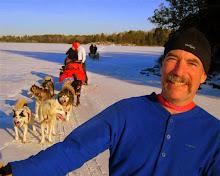
Garrett Conover paddling the new Penobscot birch bark canoe which Eric Simula, birch bark canoe builder said was the best crafted birch bark canoe he'd ever seen. The Conovers paid the Maine builder $10,000 to make it for them.

Alexandra demonstrating use of a pole . Later in the demonstration, she and Garrett double poled around in the harbor. With both of them poling in unison the canoe skimmed at high speed through the still water.

Garrett carrying a wanagan with tumpline. Later he added a large pack on top of the wanagan. He said he would generally carry 80 or 90 pounds per carry. The trick is to keep your spine aligned very straight on both the getting the load on your back (by using your knees to rotate the load up while your spine is kept rigidly straight) as well as throughout the portage.

The 2 blades of my northwoods paddles are sandwiched on my canoe spray deck with a Conover-made Northwoods paddle grip on top.
I got my cherry wood Northwoods paddle done up quite nicely and coated with multiple coats of tung oil. The Northwoods grip on it, with a long knob at the top feels natural in my hand. I finished it just in time to take it over to the North House Folk School Wooden Boat Show at Grand Marais, MN. Garrett and Alexandra Conover were the guest speakers and I wanted to take a workshop from them on the Northwoods stroke, which they have developed as a major part of their summer guiding repertoire. They are expert practitioners of traditional modes of travel in all seasons in the northwoods boreal forest. With wood and canvas canoes, wooden poles and paddles in the summer, wooden toboggan, snowshoes and cotton tents with wood stoves in the winter, they guide and teach about traditional modes of recreating on the land.
I made my northwoods paddle shorter than the more common 60+ inch paddle since I planned to use it in my solo canoe and not be using it from a standing position. After using their paddles as well as the ash one that I bought from Bourquin Boats, I like having the pronounced knob on the handle, though I need to thin down the mid section of the blade to get better flex. The workshops were great times for learning and spending time with the 2 guides of traditional northwoods skills. Alexandra paid me a compliment when she saw my new paddle by saying, "I wish that I could say that my first paddles looked as good as yours".
The weather mostly cooperated while in Minnesota except when I was on my way up the Gunflint Trail to Northern Lights Lake. The skies let loose with a deluge. Since the date was the 17th, and my birthday was June 19th I decided to move on. I had seen all that I cared to at the Wooden Boat show, had fine tuned my Northwoods stroke with the Conovers and camping was looking flooded and buggy. I decided to head over to Ely to stay the night at Wintergreen Lodge and visit with Paul and Susan Schurke. I arrived there at 10 PM, met a young graduate student staying at the lodge who was from Alaska. She was using the Wintergreen Inuit dogs in her Masters thesis, testing the canines after feeding them various wild meats; with a goal of being able to ascertain in wolf populations precisely what their eating habits are - if they are preying upon domestic livestock a simple stool test will determine if the wolf in question is the guilty one.
I talked to Paul about guiding some dog team trips this next winter. I'm going to have to train this 54 year-old body so that I'm in good enough shape for the trail!






